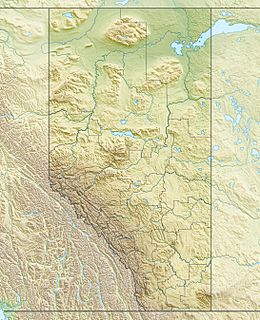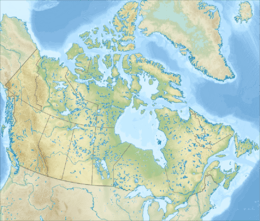Mount Wilcox (Alberta) facts for kids
Quick facts for kids Mount Wilcox |
|
|---|---|
| Wilcox Peak | |

Looking northwest to Mount Wilcox
|
|
| Highest point | |
| Elevation | 2,884 m (9,462 ft) |
| Prominence | 509 m (1,670 ft) |
| Parent peak | Nigel Peak (3211 m) |
| Listing | Mountains of Alberta |
| Geography | |
| Location | Alberta, Canada |
| Parent range | Columbia Icefield Canadian Rockies |
| Topo map | NTS 83C/03 |
| Climbing | |
| First ascent | 1896 R.L. Barrett, Walter D. Wilcox |
| Easiest route | Scramble |
Mount Wilcox, also called Wilcox Peak, is a tall mountain in the Canadian Rockies in Alberta, Canada. It stands about 2,884 meters (9,462 feet) high. You can find it right next to the Columbia Icefield visitor center in Jasper National Park. The famous Icefields Parkway road runs along the mountain's western side. From Mount Wilcox, you get amazing views of the Athabasca Glacier. It's a great spot for a moderate climb, often called a "scramble," starting from Wilcox Pass. The closest taller mountain is Nigel Peak, which is about 3.35 kilometers (2.08 miles) away to the northeast.
Contents
History of Mount Wilcox
How Mount Wilcox Got Its Name
The mountain was named Wilcox Peak in 1899 by J. Norman Collie. He named it after Walter D. Wilcox, an early explorer of the Canadian Rockies. Walter D. Wilcox was also one of the first people to successfully climb the peak in 1896.
Changes to the Mountain's Name
The name Wilcox Peak was officially accepted in 1924 by the Geographical Names Board of Canada. However, the Board changed the name to Mount Wilcox in 1928. Later, in 1956, they changed it back to Wilcox Peak.
Climate Around Mount Wilcox
Weather Conditions and Best Time to Visit
Mount Wilcox is in a subarctic climate zone. This means it has cold, snowy winters and mild summers. Temperatures can drop below -20 °C ( -4 °F). With the wind chill, it can feel even colder, sometimes below -30 °C (-22 °F). If you want to climb or visit, the best time for good weather is usually from June through September.
Water Flow from the Peak
Rain and melting snow from Mount Wilcox flow into the Sunwapta River. This river then joins the larger Athabasca River.
Gallery
-
Wilcox's north ridge seen from Tangle Ridge
-
Mt. Andromeda as seen from Wilcox Pass







